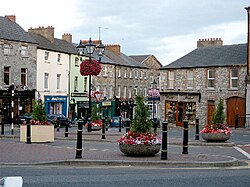Navan
| Navan Irish: An Uaimh | |
| Meath | |
|---|---|
 Market Square | |
| Location | |
| Grid reference: | N872677 |
| Location: | 53°39’10"N, 6°40’53"W |
| Data | |
| Population: | 28,158 (2011) |
| Local Government | |
| Dáil constituency: |
Meath West |
| Website: | http://www.meath.ie |
Navan is the county town of Meath.
The name of the town is of disputed etymology. In the Irish language it has been given the name An Uaimh, meaning "The Cave", and this may be its origin. It is one of the few places in the world to have a palindromic name.
The population of the urban area of Navan was 3,166 in 2006. The population of the environs was 21,141 in the same year, giving a combined total of 24,851.
History
Navan is a Norman foundation: Hugh de Lacy, who was granted the Lordship of Meath in 1172, awarded the Barony of Navan to one of his knights, Jocelyn de Angulo, who built a fort there from which the town developed.
Economy
Tara Mine, Europe's largest lead and zinc mine is in Navan. The town traditionally was famous for carpets (Navan Carpets closed in 2003) and for a thriving furniture industry (Beechmount Home Park). Both are now in decline, or have ceased, as a result of the move away from manufacture to cheaper locations like Eastern Europe. Nevertheless, Navan has rapidly expanded with the Celtic Tiger to become a large dormitory town due to its proximity to Dublin.
Sport
- Cricket: Knockharley Cricket Club, founded in 1982 – the only cricket club in Meath
- Football: Parkvilla Football Club, founded in 1966
- Horse racing: Navan Racecourse.
- Rugby: Navan RFC
Other sporting facilities include the Aura swimming pool
Arts
Solstice Art Gallery in Navan is run by the council. Art exhibitions are held there regularly.
Meath Arts Group is very active in the area.
Public Art defacing the town includes:
- Sniomh by Betty Newman Maguire in front of Navan Fire Station; a sculpture inspired by the movement of water and the merging of the rivers Boyne and Blackwater.
- The Fifth Province by Richard King on the Navan Bypass; a sculpture symbolising cultural integration of all the people of the island of Ireland
Outside links
| ("Wikimedia Commons" has material about Navan) |
- Walterstown GFC Juvenile
- Parkvilla Football Club
- Navan O'Mahonys Hurling
- Navan Railway Project
- Meath Event Guide
- Navan2Navan – Linking Ireland and Canada
